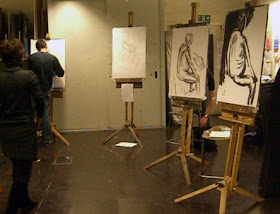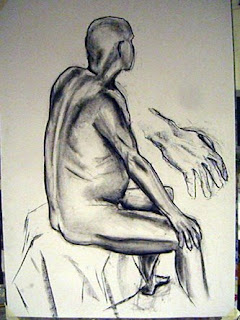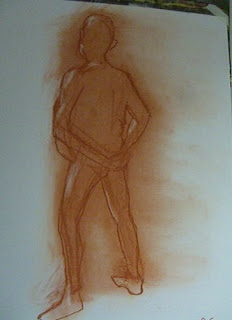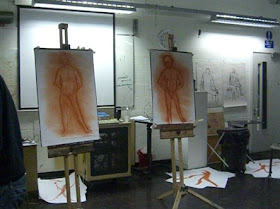The
panel that is to become nine
Little Gems is coming along. Some of the areas have their backgrounds filled in, and you can just about see pale blue thread intended for french knots (and centres for the purple flowers) and the orange variegated rayon intended for sead stitch, lying waiting -

Here's a closeup of the "pin striped" background - the leaves need nice thick edging, don't you think? -

And here's the start of the beading on the painted background. Too much of the shiny beads will be ...too much... so I'll switch to a chunky thread in the same colour-

The extra red silk fruit cover a paint mini-catastrophe.
Here are some ideas to use on these kind of pieces:
-lines of automatic embroidery patterns instead of straight stitch
-kantha stitching
-foiling in the background - perhaps not all over...
-adding blossoms among the leaves
-adding buttons (with shanks - they'll look like berries)
-beads to outline the leaves, or just one leaf
-add a bird in applique or stitch, or a butterfly, or a beaded dragonfly, or a caterpillar
-coil a snake around the branch, or sit a lizard or gecko on it
-add flower fairies or tiny humans
-stamp a pattern in the background
-use writing, as on the leaves of a book
-add skeleton leaves or leaf prints
-extra 3D fruit or leaves
 This crazy-patch was covered over with a layer of sheer, and cut back on the dark red shapes. And some lines of zigzag added here and there -
This crazy-patch was covered over with a layer of sheer, and cut back on the dark red shapes. And some lines of zigzag added here and there - "Pond life" was pieced over papers and includes a lot of embroidered weed in between the bigger stems growing from the bottom of the murky pond -
"Pond life" was pieced over papers and includes a lot of embroidered weed in between the bigger stems growing from the bottom of the murky pond - Eventually these will appear on the Little Gems website - first they need labels. Why are the labels so onerous - they take forever to get around to, but don't actually take long once you do get round to them....
Eventually these will appear on the Little Gems website - first they need labels. Why are the labels so onerous - they take forever to get around to, but don't actually take long once you do get round to them....













 All was going well until I put the chimney on the house and instead of following instructions, had to think for myself.
All was going well until I put the chimney on the house and instead of following instructions, had to think for myself. Some notes on how to do it:
Some notes on how to do it: In the afternoon we put all the tables together in the middle of the room and presented our altered books - we had 4 minutes each, and were kept strictly to time, with bouts of mad applause ending each presentation.
In the afternoon we put all the tables together in the middle of the room and presented our altered books - we had 4 minutes each, and were kept strictly to time, with bouts of mad applause ending each presentation. 









 In the cold light of next day you're finally detached from your drawing and can see what "needs attention" -- that arm, especially!
In the cold light of next day you're finally detached from your drawing and can see what "needs attention" -- that arm, especially! This was about two things - not being precious about your own drawing (or your preconceptions), and about seeing the figure from different perspectives - not only physically as you moved round the room, but psychologically as you looked at and reworked the previous drawing.
This was about two things - not being precious about your own drawing (or your preconceptions), and about seeing the figure from different perspectives - not only physically as you moved round the room, but psychologically as you looked at and reworked the previous drawing. 


 Our mission: find at least three paintings and look closely, think, write.... I chose Zoffany's 1770 "
Our mission: find at least three paintings and look closely, think, write.... I chose Zoffany's 1770 "













 Also notable, the work of
Also notable, the work of